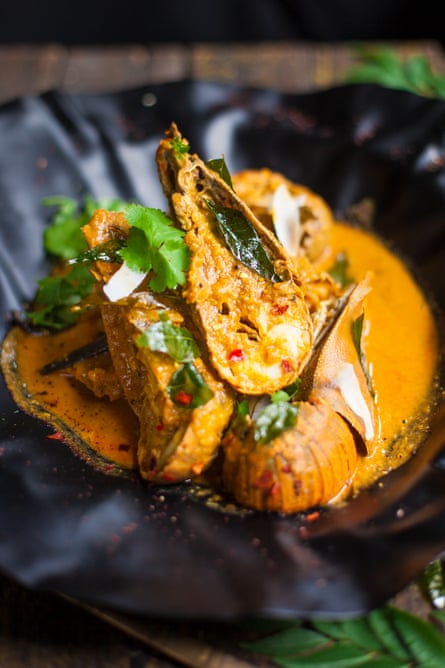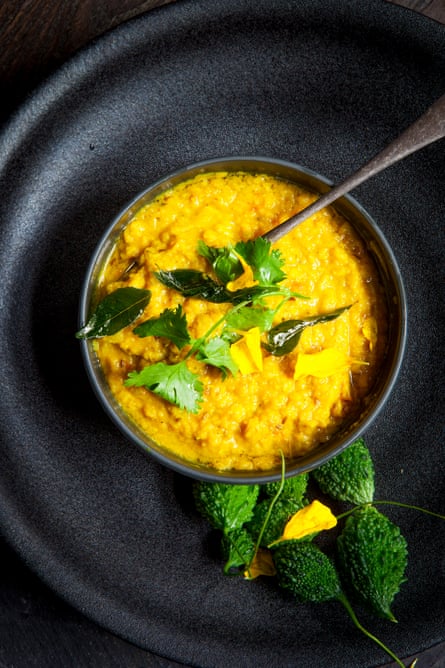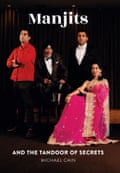
Balmain bug curry
Serves 4
Nowhere in India do we see Balmain bugs! We are so lucky to be in Australia surrounded by wonderful fresh seafood that we can play with and incorporate in our cuisine.
The Balmain bug curry is not overpowering – you can still taste the beautiful, sweet meat of the crustacean, and at the same time relish it with the smooth and creamy coconut sauce. This dish is best enjoyed with steaming-hot basmati rice, rather than roti or bread!
50g tamarind pulp, soaked in boiling water
¼ cup vegetable oil
1 tbsp black mustard seeds
3 dried long red chillies (don’t use the fresh ones for this!)
½ tsp fenugreek seeds
½ red onion, sliced very thinly
2 tbsp ginger paste (or a 7cm piece of ginger, peeled and shredded)
4 garlic cloves, finely chopped
2 tbsp curry masala sauce
Handful fresh curry leaves
3 tbsp ground turmeric
2 large Roma tomatoes, roughly chopped
375ml can coconut cream
White pepper and salt, to season
4 fresh shelled Balmain bugs (or 500g bug meat)
1 tbsp lime juice
Lime wedges and rice, to serve
Strain tamarind through a sieve into a bowl, pressing to extract the pulp. Discard the seed, and set it aside to let rest.
Heat oil in a large, heavy-based frying pan over low heat. Add the mustard seeds and saute until the seeds crackle – about 20-30 seconds. Add the chillies and fenugreek seeds and cook until chillies brown – about 20 seconds or so.
Bump up the heat to medium, then add the onion and stir until soft and translucent. Add the ginger and garlic and cook until aromatic and the house smells fantastic!
Stir in the curry masala sauce, curry leaves and turmeric. Cook, stirring continuously, for about two minutes. You will see the colour change. That’s a good thing!
Add the tomatoes and cook until soft. This should take about three or four minutes.
Stir through coconut cream and tamarind. Season to taste with salt and a touch of white pepper.
Stir through the bug meat , cover and simmer over medium heat until just cooked through (12 minutes or so).
Turn off the heat and add a splash of lime juice. Serve over rice with lime wedges.
Deep’s yellow dal
In my teens, when I once had friends over for dinner. I tried to make chicken curry to show off my skills as a master chef of Indian cuisine, and I failed miserably, leaving me in an embarrassing situation.
So, what does a young, single, Indian-Aussie boy who’s trying to show off his culinary skills do in the middle of the night do to entertain a crowd? He makes the simplest dish that’s guaranteed to put a smile on everyone’s face! Dal!
Note that the amount of water used in a dal recipe depends on personal preference and how you are going to eat the dal. If eating with roti, add less water and make it thicker and stew-like. If eating with rice, add more water to make it more liquid, which coats the rice better.

Serves 4
For the dal
½ cup red lentils (masoor dal)
½ cup yellow lentils (moong dal)
2 tbsp ghee
½ onion, finely chopped
1 tsp garlic paste
1 tsp ginger paste
½ tsp ground turmeric
Salt to taste
For tempering
1 tbsp vegetable oil
½ small onion, sliced (optional)
4 garlic cloves, sliced
2 dried red chillies, whole
1 tsp cumin seeds
Coriander leaves, to garnish
Rice, roti, chapati or naan, to serve
In a colander, rinse red and yellow lentils under cold water. Usually, they don’t need to be soaked because they cook quickly, but soak them for a couple of minutes until you gather the rest of the ingredients.
Heat ghee in a large pan and add the onion, garlic paste, ginger paste and turmeric . Saute for one minute and then add the lentils and salt.
Add water, stir through and bring to a boil.
Once the water boils, put heat to low and cook for about 15 minutes until lentils are soft. (If using a pressure cooker this will take two minutes.)
Use a whisk or a wooden spoon to mix the lentils vigorously. This mashes the lentils creating a thick, chunky stew. Add more water if desired, or just cook it for a few minutes if a thicker gravy is preferred.
Meanwhile, for the temper, heat the oil in a small frying pan or small wok a few minutes before the lentils have finished cooking. Add the onion and fry until lightly golden. Add garlic and saute for one minute, or until golden brown. Add chillies and cumin and cook for about 30-60 seconds until they change colour and release their aroma.
Carefully pour the tempering mixture (including the oil) over the lentils and mix through. Garnish with coriander, and serve with rice, roti, chapati or naan.
Manjit’s shahi tukda
One of my favourite things is making desserts. However, if deserts are too sweet then they have a sickly sort of effect.
After a big dinner, or even an afternoon snack, I’ve always enjoyed making this scrumptious sweet dish.
Surprisingly we have incorporated it into our events where some of our non-Indian clients have tasted it and described it as the Indian version of a bread and butter pudding!

10 slices white bread
2 cups ghee, for deep-frying
5 cups full-cream milk – as creamy as possible, it will make a massive difference
1 tbsp milk powder
15 to 18 strands saffron
2 tbsp pistachios, blanched and sliced
2 tbsp assorted dried fruit, chopped, to garnish
½ cup white sugar
1 tsp rosewater
1 sliver silver or gold leaf, to garnish
1 tbsp condensed milk
Remove the crusts from the bread. Using a round cookie cutter, slice the bread into rounds.
Heat the ghee in a pan and shallow-fry the bread for about one minute, then turn over and fry for another minute, or until light brown and crisp. Drain on absorbent paper towel to remove the excess grease. Do not burn the ghee!
In a saucepan, combine milk and milk powder, and gently bring to a simmer. When the cream floats to the top, gently push aside the cream layer so that it sticks to the side of the pan.
Continue simmering the milk and collecting the cream layer on the sides. The milk will thicken and reduce by half.
Add the pistachios and saffron, followed by the sugar, sweetened condensed milk and milk powder. Simmer for five minutes, stirring continuously.

Remove from the heat, and stir through the rosewater. Chill in the fridge for about 30 minutes.
Carefully arrange bread pieces on a serving dish, and pour over the chilled, reduced milk. Drizzle with condensed milk and garnish with silver leaf and dried fruit. Best served chilled … like my son Deep!



